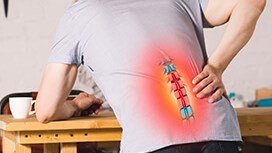How Can Lower Back Pain be Managed at Home?
&srotate=0)
Up to 80% of people will experience back pain at some point in their lives. But the shared experience often makes people assume that all back pain is the same or that it's something they will eventually just "get over." Unfortunately, lower back pain can affect how you sit, stand, lift, move, and lie down, making it hard to do anything – even relax at home.
Dr. Matthew Kohler has deep medical knowledge of the spine and its network of nerves. At Ospina Medical in NYC, NY, we aim to provide patients with the best possible treatment for lower back pain in Manhattan.
Keep reading to find out what patients suffering from lower back pain can do at home to augment their in-office care.
What causes lower back pain?
Stress from lifting, bending, sitting, and repetitive movements can all damage the complex system in our lower backs. As we age, it takes less for our lower backs to radiate pain as bones and joints start to wear out or lose their "cushioning." And when nerves are involved, we may even feel pain radiate down the buttocks and leg.
Lower back pain can be related to changes in the following structures in and around the spine:
- Spinal discs
- Vertebrae
- Facet joints
- Nerve roots
- Muscles
- Tissues
It's often challenging to pinpoint one specific cause or location that requires modification since our movements and anatomy are so interconnected.
What can I do to manage lower back pain at home?
At Ospina Medical, Dr. Kohler is a compassionate listener and rigorous diagnostician dedicated to getting to the bottom of your lower back pain. However, many people prefer to try home remedies for the first few days or augment their treatment with home care.
Here are some ways to relieve lower back pain at home:
Posture correction
If your lower back pain is related to sitting or standing for long periods, adjusting your posture and investing in ergonomic seating, footwear, or wearable correctors can help alleviate long-term pain. Proper posture helps your bones and joints stay in alignment, can help alleviate stress on ligaments, prevent muscle strain, and decrease wear on the joints. It can also help prevent lower back pain.
Stretching and targeted exercises
Exercise strengthens muscles and releases endorphins that provide natural pain relief. But when a workout or walk is too painful, stretches that target the lower back muscles can help relieve pain. Gentle stretches such as lying on your back and gently pulling one or both knees toward the chest can often provide relief at home. However, it's wise to consult Dr. Kohler before engaging in targeted exercise since it can aggravate some conditions. Our physical therapy team can also help identify the best exercises or stretches for your unique issues.
Heat or cold therapies
Patients may have success with applying cold to acute injuries to reduce swelling, followed by heat. For chronic back pain, you may find heat more soothing for chronic muscle or joint pain. Heat therapy typically requires around 10 – 30 minutes to be effective.
Limited bed rest
While exercise is one of the best ways to prevent and address some lower back pain, you may need to rest more than usual, especially if an acute injury requires healing time. For chronic back pain, bed rest can do more harm than good. That's why it's crucial to consult with the team at Ospina Medical to get an assessment of your condition first.
Get advice and treatment for lower back pain in New York City
Patients can manage some minor back pain at home. But if you experience pain in your lower back for more than 3 – 4 days, or pain is severe following an injury, it's best to see a doctor to identify the precise structures causing you pain.
If you live near New York City and suffer from lower back pain, make an appointment to see Dr. Matthew Kohler at Ospina Medical for a personalized treatment plan today.